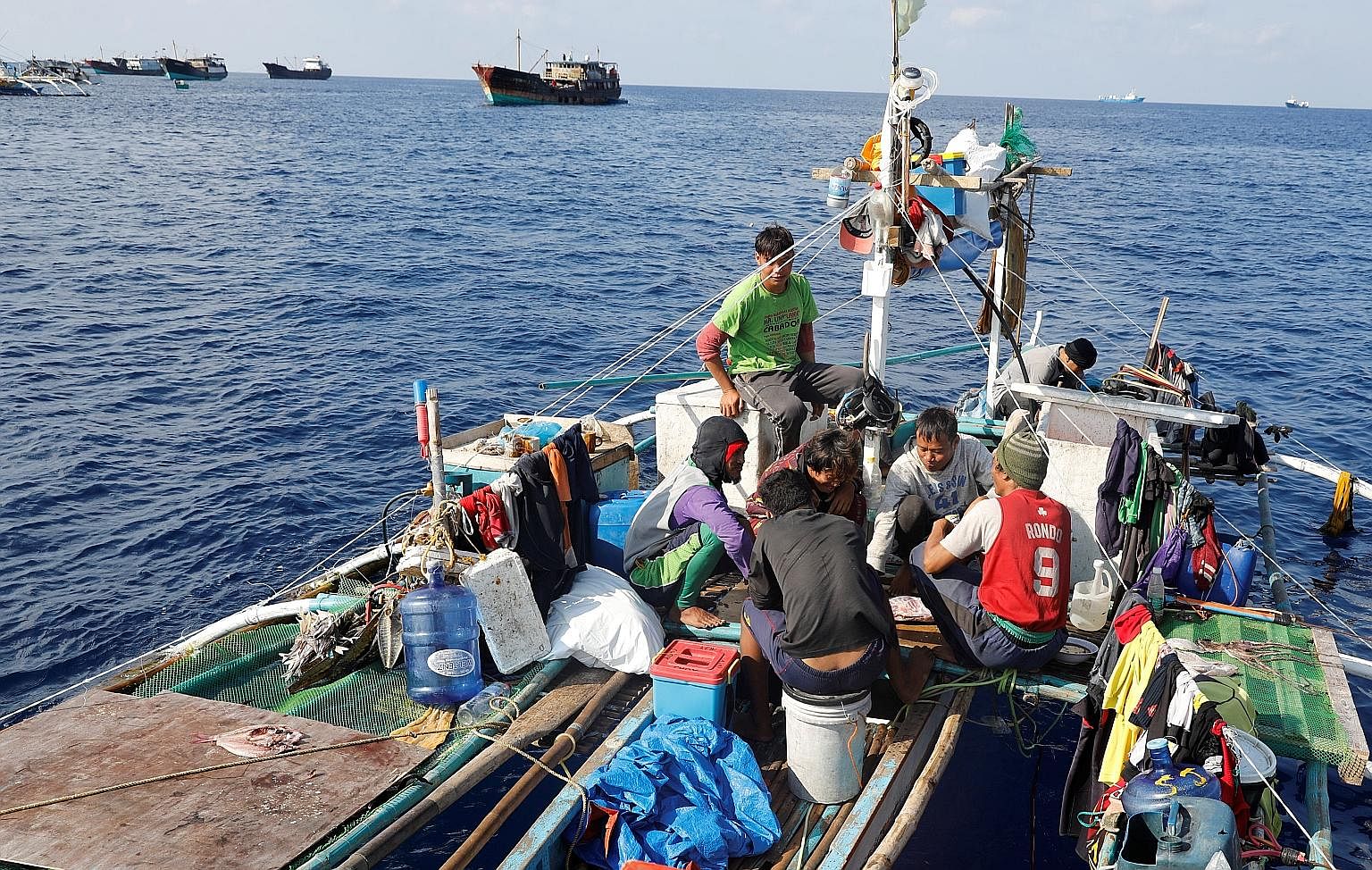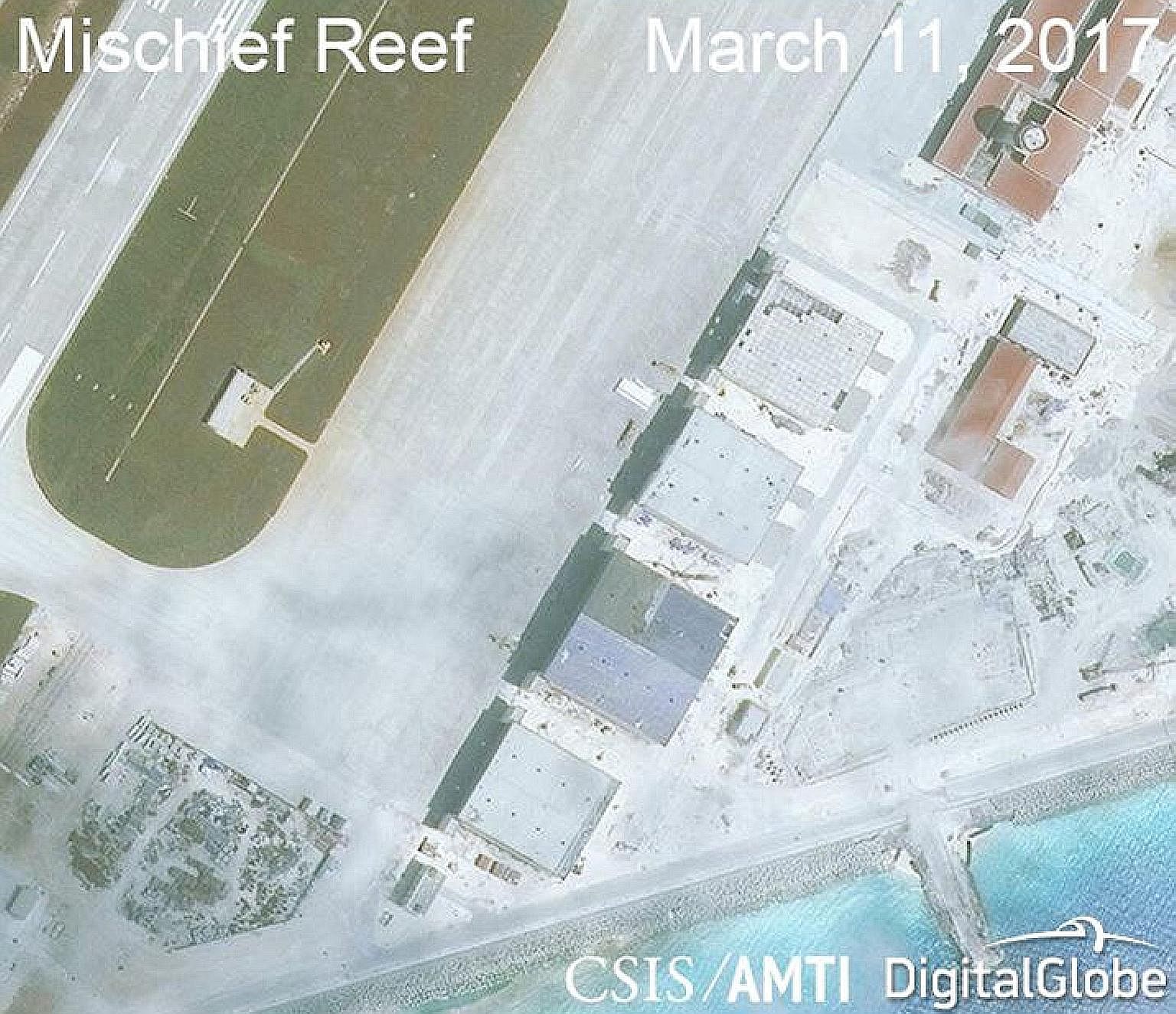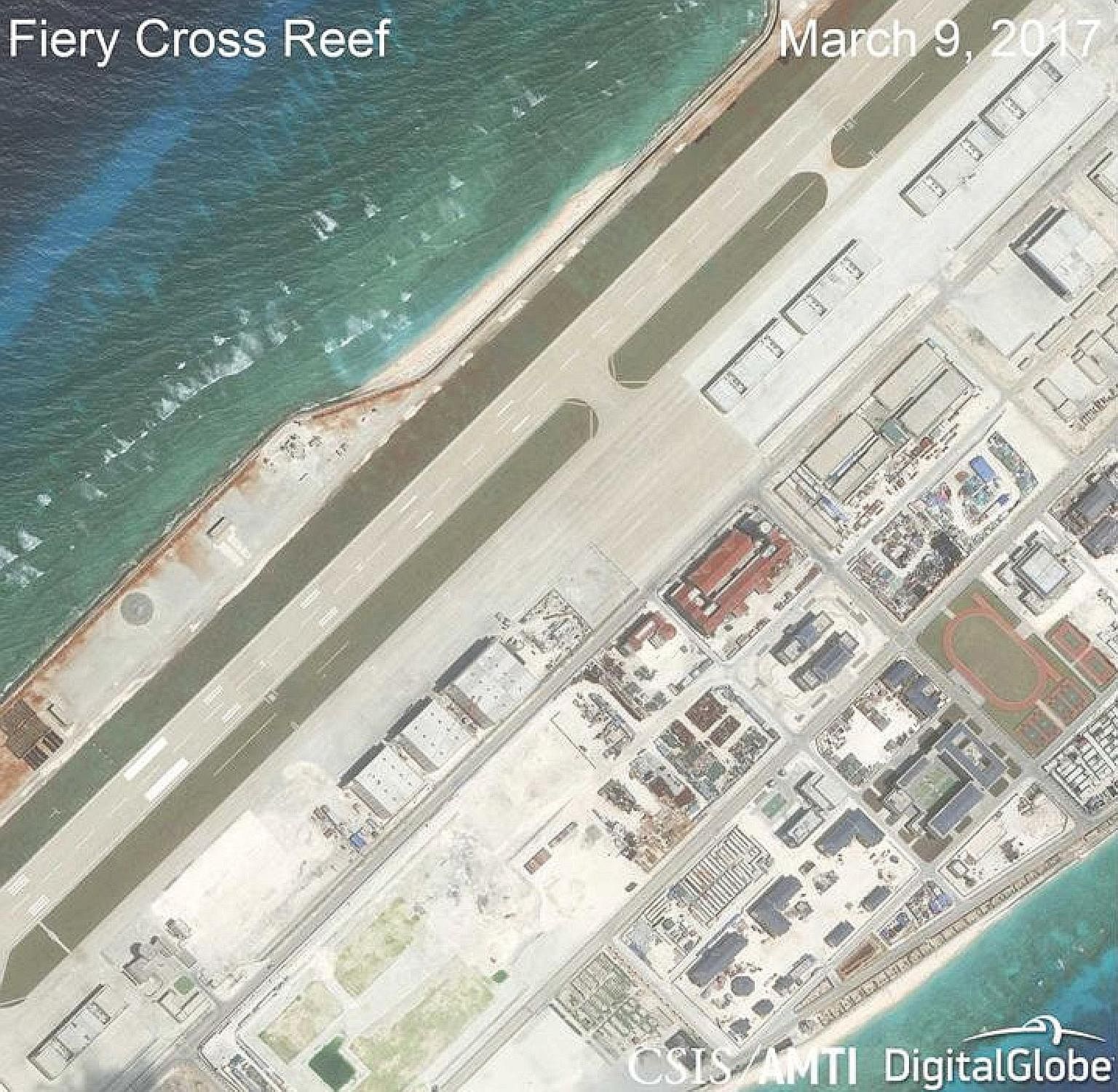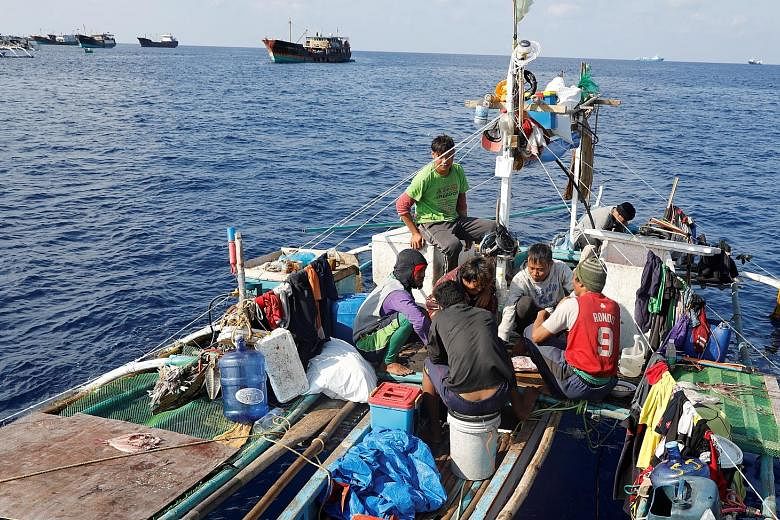BEIJING • Territorial disputes in the South China Sea among several countries have been ongoing for decades but tension has been increasing in recent years.
Much of it is caused by what has been perceived as China's growing assertiveness in its claims, beginning in 2009 with its presentation of a map to the United Nations. The map showed its claim over almost the entire South China Sea represented by a U-shaped, nine-dash line.
This put China in clear contention with all the other claimants - Taiwan and Asean member states Brunei, Malaysia, the Philippines and Vietnam.
But part of the tension is also caused by the United States entering the fray as it rebalanced to the Asia-Pacific in 2011, paying more attention to this region.
Here's a look at why the South China Sea has become unquiet.
WHO IS CLAIMING WHAT IN THE WATERS?
China claims nearly all of the South China Sea in accordance with an official map with a U-shaped, nine-dash line, drawn in 1947 by the then Kuomintang government of the country. China bases its claims on historical naval expeditions dating back to the 15th century.

It is not clear if China claims just the rocks, reefs and isles and the 200-nautical mile exclusive economic zone they might generate or the entire area within the U-shaped line. An exclusive economic zone is an expanse of water and seabed within 200-nautical miles of a country's coastline to which the country can claim exclusive rights for fishing and other economic activities.
Taiwan's claims are similar to those of China as they are based on the same 1947 official map. However, its claims are to the land features within the U-shaped line, including the Spratly Islands, Paracel Islands, Pratas Islands, Macclesfield Bank and Scarborough Shoal.
Brunei and Malaysia claim parts of the Spratly Islands that overlap with claims by China, Taiwan, Vietnam and the Philippines.
Vietnam lays claims to all of the Paracel and Spratly isles while the Philippines claims almost all of the Spratly Islands and Scarborough Shoal.
Most claimants occupy some of the reefs and islands that they lay claim to, with some having military garrisons on these land features.
While Indonesia does not have any claims to these disputed areas, China's nine-dash line claim overlaps with the exclusive economic zone of Indonesia's Natunas Islands.


WHY ARE THESE COUNTRIES FIGHTING OVER UNINHABITABLE BARREN ROCKS, REEFS AND ISLES?
The waters around these islands are rich with fish and shellfish and afford livelihoods to the fishermen of these countries. Laying claim to these islands would be laying claim to the fishing grounds around these islands.
-
About the Big Quiz

Each Monday, the paper's journalists will address burning questions in the Opinion section, offering unique Singaporean perspectives on complex issues.
These primers form part of the outreach of The Straits Times- Ministry of Education National Current Affairs Quiz, nicknamed The Big Quiz, which aims to promote an understanding of local and global issues among preuniversity students.
Underpinning this year's Big Quiz is a focus on disruption, a timely issue as various sectors and industries adapt to this global change.
The theme will be featured in six campus talks helmed by editors and correspondents.
Six quiz rounds will also be held for students to demonstrate their current affairs knowledge.
The nationwide event is jointly organised by The Straits Times and the Ministry of Education, with the Singapore Press Holdings Foundation as its presenting sponsor.
Pre-university schools and institutions can note these dates for participation in the coming quiz rounds and talks:
•April 19 at Nanyang Junior College
•April 26 at Temasek Junior College
•May 12 at Eunoia Junior College
•For more information or to view additional resources: https://www.straitstimes.com/tags/the-big-quiz
•For more information on this week's primer topic, go to: http://str.sg/4Xew
There are also potential oil and gas deposits beneath the seabed of the disputed areas, although such resources in the Spratly and Paracel islands are not large, according to the US Energy Information Administration (EIA). An EIA analysis showed that most fields containing oil and natural gas are in uncontested parts of the South China Sea, close to the shorelines of coastal countries.
According to the EIA, the South China Sea in total has about 11 billion barrels of oil and 190 trillion cubic feet of natural gas of proved or probable reserves. These are similar to the amount of proved reserves in Mexico.
HOW ELSE IS THE SOUTH CHINA SEA IMPORTANT?
The South China Sea is one of the world's busiest waterways through which one-third or more than US$5 trillion (S$7 trillion) of the world's trade passes annually. Crucially, much of the oil supplies of the energy-starved North-east Asian countries of China, Japan and South Korea also go through this waterway. For these countries, keeping the sea lanes open and free of potential blockades is important.
China is particularly worried about being blockaded as there are American allies to its east - Japan, South Korea and the Philippines - and the US navy has long been dominant in the waters of the region.
WHY HAS TENSION ESCALATED IN RECENT YEARS?
The South China Sea territorial disputes started coming to the fore in 2009 when Malaysia and Vietnam filed a joint submission to the United Nations (UN) Commission on the Limits of the Continental Shelf to extend their continental shelves beyond the standard 200 nautical miles from their coastlines.
China objected to this, saying it has "seriously infringed" on China's sovereignty over islands in the South China Sea. It sent a diplomatic note to the UN that included the map with the U-shaped line claim to almost the entire sea, sparking protests from the other claimants.
The following year at the Asean Regional Forum, a regional security meeting, then US Secretary of State Hillary Clinton weighed in on the disputes, to which the Chinese responded sharply, raising tension another notch.
In 2011, the US announced a rebalance to the Asia-Pacific region and this was accompanied by a strengthening of US alliances and partnerships in the region.
The growing US focus on the region led to a sense among the Chinese of collusion between the US and other regional claimant states over the disputes and this added to the unease in the region.
In 2012, following a stand-off between the Chinese and Filipinos in the Scarborough Shoal over a fishing dispute, the Chinese blockaded the area, preventing Filipino fishermen from fishing there. Manila then brought a suit against China's claims in the South China Sea, in 2013.
Through the years, China staked its claims in the South China Sea in various ways. Its fishermen ventured far from the Chinese shores protected by accompanying coast guard vessels. It imposed a unilateral summer ban on fishing in disputed waters and detained or chased away foreign fishermen from these waters during the ban period.
China started building artificial islands on several land features it occupies and built airstrips and military facilities on them, leading to accusations that it was militarising the South China Sea.
Matters came to a head in July last year when the international arbitral tribunal ruling on the case brought by Manila ruled that China's claims were invalid. China rejected the ruling. But things have calmed down somewhat as the Philippines under President Rodrigo Duterte has put aside the ruling in favour of economic cooperation with China.
HOW HAVE COUNTRIES IN THE REGION SOUGHT TO MANAGE THE DISPUTES?
While not all 10 Asean nations are involved in the territorial disputes, the grouping has sought to be united on the issue. It has tried to manage the disputes to prevent them from escalating and destabilising the region, by negotiating an agreement with China. The result was the 2002 Declaration on Conduct of Parties in the South China Sea.
Among other things, this non-binding agreement stated that the parties concerned should resolve their disputes by peaceful means through direct negotiation in accordance with international law, including the 1982 UN Convention on the Law of the Sea. It stated that signatories should exercise self-restraint in the conduct of activities that could escalate the disputes.
The agreement also provided for the eventual adoption of a legally binding code of conduct (COC) to manage the disputes.
The Declaration has not been fully observed by the claimant states and talks on the code have been sporadic.
However, the case brought by the Philippines gave impetus to talks on the COC and after the tribunal ruling, the Chinese agreed to a mid-year deadline this year for the completion of a framework for the code.
A draft of the framework was completed early this year.
Singapore is not a claimant state and does not take sides in the South China Sea disputes. But as a small, open, trade-dependent nation, it wants to uphold values such as freedom of navigation and overflight in the region, and a rules-based regional and international order that protects the rights and privileges of all states and respects legal and diplomatic processes in the resolution of disputes.
WHY HAVE COUNTRIES FROM OUTSIDE THE REGION ENTERED THE FRAY?
China's assertiveness has led claimant states like Vietnam and the Philippines, and other countries in the region, to seek closer security ties to outside powers such as Japan and the United States.
Vietnam and the Philippines have bought coast guard vessels from Japan while the Philippines has strengthened its security pact with the US.
Vietnam has also begun naval exercises with the US.
Japan, for its part, wants to ensure that the sea lanes of the South China Sea remain open, as much of its trade and oil supply go through them. It worries about China's militarisation of the South China Sea and its potential to control the waterway.
The US has maintained it does not take a position in the disputes but that it has a national interest in the freedom of navigation and overflight, open access to Asia's maritime commons and respect for international law in the South China Sea.
It has conducted several freedom of navigation operations close to islands claimed by the Chinese to challenge what it sees as China's excessive maritime claims.
It has also sought to strengthen its security alliances and partnerships in the region.
There are analysts who see the US actions as a pushback against Chinese assertiveness, which Washington sees as a challenge to its dominance in the Asia-Pacific region.
Indeed, China's assertiveness goes beyond its territorial claims. It also seeks to dominate the South China Sea militarily in the long term, analysts have said.
HOW CAN ASEAN MANAGE CHINA'S GROWING REACH?
While Asean has welcomed the US pivot to the region as a hedge against China, it cannot rely fully on the US. As rivals, the US and China will want to find ways to accommodate each other, possibly at the expense of the region's interests.
What Asean can do is to build Asean unity and cohesion, multilateralism and open regionalism.
Unity and cohesion will give the grouping strength in numbers to stand firm on issues like the South China Sea disputes.
It can dilute China's influence in the region by strengthening its multilateral institutions like the East Asian Summit and the Asean Regional Forum, which involve countries and groupings with interests in the region, such as the US, India and the European Union.
Likewise, its open regionalism which gives countries outside the region a stake in it can help to counter China' s influence.

Have a burning question related to this week's Primer topic?
E-mail us at askST@sph.com.sg
For more information, go to www.straitstimes.com/askST


